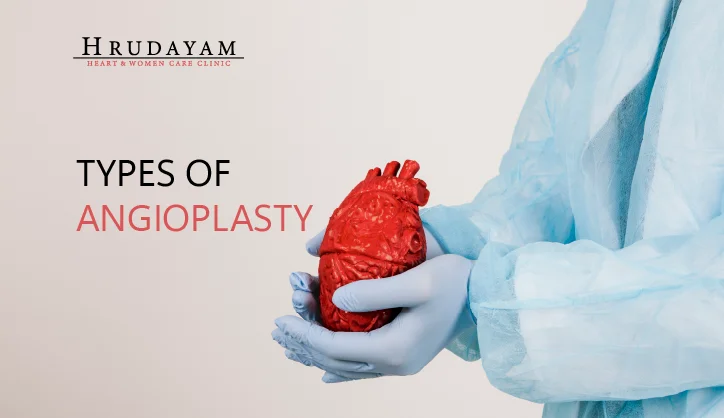Hrudayam Heart & Woman Care Clinic
What is Coronary Angioplasty?
What are the Types of Angioplasty?
There are three primary types of angioplasty:
- Balloon Angioplasty
In this procedure, a small balloon is inserted into the affected artery and inflated to widen the passage and clear blockages or plaque.. - Stent Angioplasty
This procedure involves placing a stent—a small mesh tube—inside the artery to keep it open and maintain normal blood circulation. - Laser Angioplasty
A laser is used to break down plaque and open the blocked artery.

When Do Doctors Usually Recommend Angioplasty?
Angioplasty is typically recommended by doctors when a patient has significant artery blockages, often accompanied by symptoms like chest pain or early signs of a heart attack. It is usually necessary when lifestyle changes and medications are not enough to effectively manage these symptoms
How do I Prepare for Angioplasty?
Before your angioplasty, the doctor will provide you with detailed instructions. You may also be prescribed medications to help thin your blood. It’s important to inform your doctor about any allergies or other health conditions you have.
What Happens During the Procedure?
During the procedure, the doctor will administer local anesthesia to numb the area where the catheter will be inserted. Using X-ray guidance, the specialist will carefully insert the catheter into an artery and guide it toward the coronary arteries. Once in place, a small balloon at the catheter’s tip is inflated to compress the plaque against the artery walls, helping to widen the artery and enhance blood flow.
What are the Benefits of this Procedure?
Coronary angioplasty offers several additional benefits, including relieving symptoms like chest pain and reducing the risk of heart attacks. By restoring blood flow to the heart muscle, it enhances the quality of life. Furthermore, it is a less invasive procedure compared to open-heart surgery.
What are the Risks?
- Coronary Artery Injury: The procedure may cause damage or rupture of the artery, possibly requiring emergency open-heart surgery. This risk is more common during stent angioplasty.
- Arrhythmias: The heart may experience irregular rhythms, either beating too fast or too slow, during the procedure. This can be addressed with medications or a temporary pacemaker.
- Bleeding and Infection: Since a catheter is inserted into a blood vessel, typically in the arm or leg, there is a risk of bleeding, bruising, or infection at the insertion site.
How Long Does it take to Recover?
After your coronary angioplasty procedure, you can typically leave the hospital within 3 to 6 days. However, the exact timing depends on your recovery progress and overall health. The type of angioplasty performed also plays a role in your recovery time.
What is the Success Rate of Coronary Angioplasty?
Coronary angioplasty has a relatively high success rate, though it can vary depending on the patient’s condition and the specific procedure performed. In a notable study at a medical institute, 140 octogenarians underwent percutaneous coronary intervention (PCI) and were monitored clinically for 14 months. The findings were remarkable, with a primary success rate of 90% observed among 224 patients, most of whom had angina or myocardial infarction. Numerous case studies have examined success rates, which generally range between 70% and 90%.
Conclusion
If you’re experiencing chest pain, it’s important to seek a diagnosis from an expert. Dr. Chetan Rathi is available around the clock and brings years of experience, along with up-to-date knowledge of the latest medical advancements and procedures to provide the best care for his patients.
FAQs of Coronary Angioplasty
Does Heart Function Improve after Angioplasty?
After your angioplasty, your heart functions properly, and it will cater to the blockages in the arteries causing problems. The procedure helps to clear these blockages, and it allows better blood flow to the heart muscle.
How Much Does Angioplasty Cost?
The cost of angioplasty may vary depending on various factors such as hospital location, doctor’s speciality, type of angioplasty, and your health condition. It also involves expenses for the procedure itself, hospital stays, doctor fees, and medications.
When Should I Call my Heart Specialist?
You should get in touch with a heart specialist like Dr Chetan Rathi. If you experience any symptoms like chest pain, discomfort, and shortness of breath. In addition, if you witness dizziness, fainting, or irregular heartbeat.
How is the Quality of Life after Coronary Angioplasty?
The quality of life after coronary angioplasty will improve drastically. It can relieve symptoms like chest pain, and improve heart function.
How Can I Take Care of Myself?
Remember to follow your doctor’s instructions closely, take regular medications and attend follow-up appointments. If you notice any uneasiness, then make sure to visit the nearest clinic.
